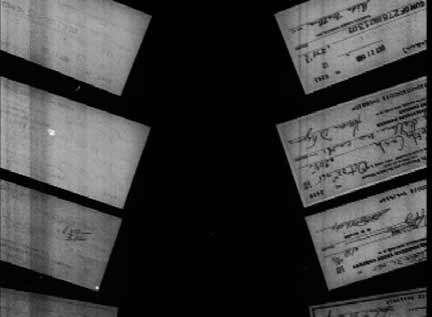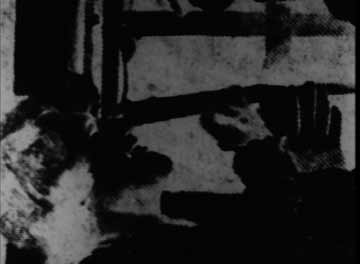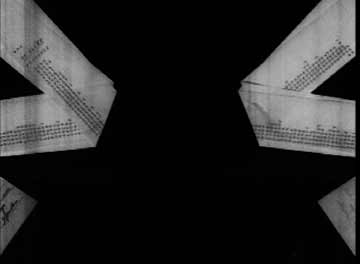|
 October
13, Saturday, 7:30PM (Free Admission) October
13, Saturday, 7:30PM (Free Admission)
Location: Carpenter Center at Harvard University
24 Quincy St. Cambridge, MA (Room B04)
Balagan & Mass Art Film Society Presents:
Colen Fitzgibbon Retrospective (In person)
Introduced by Sandra Gibson and Luis Recoder
Post-screening discussion moderated by Scott MacDonald
Balagan is delighted to bring a special retrospective screening to Boston of the works of Colen Fitzgibbon. Thanks to the caring and meticulous preservation work of Sandra Gibson and Luis Recoder, Balagan is thrilled to be able to bring Coleen's films back to the screen and into the contemporary dialogue of American avant-garde film history.
Coleen Fitzgibbon, b. 1950
Fitzgibbon was active as an experimental film and video artist under the pseudonym "Colen Fitzgibbon" between the years 1973-1980. A student of Owen Land (aka "George Landow") and Stan Brakhage during her years as a film/video student at Art Institute of Chicago (1971-73), she later attended the Whitney Museum of American Art's Independent Study Program under Ron Clark (1973-74), studying with international artists such as Michael Snow, Yvonne Rainer, Vito Acconci, Donald Judd, and Dennis Oppenheim. Between the years 1973-1976 Fitzgibbon made some of her most rigorous experimental work to date on 16mm and super 8 film, screening at numerous international film festivals and museums, including EXPRMNTL 5 at Knokke-Heist in Belgium, Institute of Contemporary Art in London, Anthology Film Archives, Collective For Living Cinema, and Millennium Film Workshop in New York.  Fitzgibbon's films of this period can be considered as part of a second wave of structural filmmakers. Influenced by the modernist cinema of the mid-to-late 60's and heralded by P. Adams Sitney as “structural film” – an emerging canon of work which included films by Owen Land, Michael Snow, Paul Sharits, Tony Conrad, Hollis Frampton, Joyce Wieland – Fitzgibbon's films were deeply rooted in the high formalist aspirations of the avant-garde. In one of her more minimalist films, Internal Systems, the viewer is presented with nothing but a blank monochromatic frame slowly shifting through various intensities of color saturation, flickering/shuttering repeatedly from light-to-dark (and back again) for a duration of 45 minutes. Even what may seem to be some of her more accessible work pushes the limits of perception. In the shorter 12 minute FM/TRCS, light, color, shape, texture, pattern, granularity, solarization, contrast, and movement incessantly flow as if from some undisclosed place, the effect of which is an incessant restlessness of the filmic frame. In her notes on the film, Fitzgibbon writes: “ FM/TRCS is a study of image destruction and its subsequent effect on recognition and suggestion of new images.” Fitzgibbon's films of this period can be considered as part of a second wave of structural filmmakers. Influenced by the modernist cinema of the mid-to-late 60's and heralded by P. Adams Sitney as “structural film” – an emerging canon of work which included films by Owen Land, Michael Snow, Paul Sharits, Tony Conrad, Hollis Frampton, Joyce Wieland – Fitzgibbon's films were deeply rooted in the high formalist aspirations of the avant-garde. In one of her more minimalist films, Internal Systems, the viewer is presented with nothing but a blank monochromatic frame slowly shifting through various intensities of color saturation, flickering/shuttering repeatedly from light-to-dark (and back again) for a duration of 45 minutes. Even what may seem to be some of her more accessible work pushes the limits of perception. In the shorter 12 minute FM/TRCS, light, color, shape, texture, pattern, granularity, solarization, contrast, and movement incessantly flow as if from some undisclosed place, the effect of which is an incessant restlessness of the filmic frame. In her notes on the film, Fitzgibbon writes: “ FM/TRCS is a study of image destruction and its subsequent effect on recognition and suggestion of new images.”
 Her experience in the Whitney's ISP program further enriched her critical disposition toward her subject matter, in particular the emerging discourse of institutional critique. Structural film's critique of the cinematographic apparatus is broadened to encompass other institutions, techniques, and practices epitomized in her performance film Document (1975-76), previously titled Public Records . The material for this film was generated while Fitzgibbon was working for the then thriving information retrieval system of the microfilm industry. The 16mm unperforated and frameless strip of Kalvar microfilm was sent to a perforation machinist and then projected on an analytic film projector. As a film performance, Document accelerates, slows down, and freezes the microfilm disclosing public records as diverse as bank receipts, deeds, checks, and other transactions between the private and the public. (Document will be performed in this program with analytic projector for the screening by artist Luis Recoder.) Her experience in the Whitney's ISP program further enriched her critical disposition toward her subject matter, in particular the emerging discourse of institutional critique. Structural film's critique of the cinematographic apparatus is broadened to encompass other institutions, techniques, and practices epitomized in her performance film Document (1975-76), previously titled Public Records . The material for this film was generated while Fitzgibbon was working for the then thriving information retrieval system of the microfilm industry. The 16mm unperforated and frameless strip of Kalvar microfilm was sent to a perforation machinist and then projected on an analytic film projector. As a film performance, Document accelerates, slows down, and freezes the microfilm disclosing public records as diverse as bank receipts, deeds, checks, and other transactions between the private and the public. (Document will be performed in this program with analytic projector for the screening by artist Luis Recoder.)
Institutional critique continued in more performance based work with artist Robin Winters under the collaborative name X + Y (1976-1978). During this brief period X + Y made a body of work spanning film, video, installation, and performance. Fitzgibbon's collaborative sensibilities continued when she co-founded the New York based Collaborative Projects, Inc. (Colab). Forming in 1977, Colab was an organized group of 30 to 60 artists seeking an alternative outlet that would call into question and challenge the emergence of the “art market” in their New York milieu. Fitzgibbon recalls: “The Colab period was an attempt at a non-hierarchical socialist art movement within NYC's international capital finance system, and had been inspired by other earlier groups such as Oldenberg's Store, The Fox publications, Judson Dance Group and the teachings of Ron Clark, as well as others.” The roster of artists in Colab included Robin Winters, Jenny Holzer, Peter Fend, Liza Bear, Kiki Smith, Tom Otterness, Charlie and John Ahearn – to name a few. An integral member in Colab, Fitzgibbon organized artist shows in her loft studio at 5 Bleeker Street with thematic titles such as “Income & Wealth,” “Manifesto” (with Jenny Holzer and Robert Cooney), “Just Another Asshole” (with Barbara Ess, Jane Sherry, and Virginia Piersol); as well as being one of the key organizers of the notorious Times Square Show in 1980.
|
